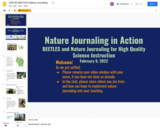
Running Slide Deck from WL BEETLES & Nature Journaling Online Sessions
- Subject:
- Environmental Literacy and Sustainability
- Material Type:
- Learning Task
- Author:
- Tiffany Lodholz
- skylar primm
- Sandy Benton
- Date Added:
- 02/09/2022

Running Slide Deck from WL BEETLES & Nature Journaling Online Sessions
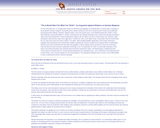
For four years after the U.S. dropped atom bombs on Hiroshima and Nagasaki to end World War II, America held a monopoly on the production of atomic weapons. During this period, debate centering on the use of nuclear bombs in future wars proliferated among government officials, scientists, religious leaders, and in the popular press. In the following article from Collier's, former Navy lieutenant commander William H. Hessler, using data from the Strategic Bombing Survey, argued that saturation bombing of urban areas during World War II, while devastating for civilians, did not achieve war aims. A future atomic war, therefore, might well destroy cities but fail to stop enemy aggression. Furthermore, with a much higher urban concentration than the Soviet Union, the U.S. had more to lose from atomic warfare. The article, while providing detailed explanations of the bomb's destructive capability, demonstrated the lack of information available regarding the long-term medical and ecological effects of radioactivity. Hessler's prose also evoked both the fascination that gadgetry of atomic warfare held for Americans of the time and the fear many felt about the risks involved in putting this technology to use. On September 24, 1949, one week after publication of this article, news that the Russians had conducted atom bomb tests shocked the nation. The following April, a National Security Council report to President Harry S. Truman advised development of a hydrogen bomb--some 1,000 times more destructive than an atom bomb--and a massive buildup of non-nuclear defenses. The subsequent outbreak of war in Korea in June 1950 justified to many a substantial increase in defense spending.
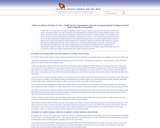
In 1981, the U.S. medical community noticed a significant number of gay men living in urban areas with rare forms of pneumonia, cancer, and lymph disorders. The cluster of ailments was initially dubbed Gay-Related Immune Disease (GRID), but when similar illnesses increased in other groups, the name changed to Acquired Immune Deficiency Syndrome (AIDS). The mid-1980s saw a number of advances toward understanding and treating the disease, but no vaccine or cure was forthcoming. Gay advocacy and community-based organizations began providing services and pressuring government to increase funding for finding a cure and helping victims. As two representatives of AIDS health services organizations stated in the following 1987 testimony to Congress, AIDS spread in disproportionately high numbers throughout U.S. minority and disadvantaged communities. They advocated increased federal funding for prevention efforts targeted at minority communities and administered by community-based organizations. Despite such efforts, the number of minority AIDS cases continued to rise sharply, and by 1996, African Americans accounted for a higher percentage of reported adult cases of AIDS (41%) than did whites.

Storytelling is an important part of traditional Native American culture. It is important to remember that some stories can only be told in the Winter out of respect for the names that can only be told when the snow is on the ground. Please use the references shared on this page in accordance with the respectful practice of Winter only storytelling. As always, it is best to have the guidance of an experienced elder and / or storyteller when planning best use in the classroom. This unit blended the use of traditional knowledge with textbook based science concepts to show the interconnection between them. Many traditional stories give an explanation of plant and animal adaptations that have a scientific benefit for the organism.

This resource folder provides an adaptation to two units in the OpenSciEd Curriculum: P.1 Energy Flow from Earth's Systems and P.5 Electromagnetic Rdition. Included is a varation on the student workbook that allows more space for student work to be completed, and embeds readings and activites. Also included in the folder are teacher resources pages that keep all important ideas, links, and other resources handy for each lesson. Materials created by OpenSciEd are shareable under a Creative Commons Attribution-NonCommercial-ShareAlike 4.0 International (CC BY-NC-SA 4.0) license. More information can be found at: https://www.openscied.org/openscied-terms-of-use-and-privacy-policies/
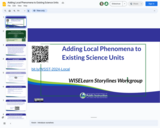
This module guides educators through five methods for adding local phenomena to existing units. It includes rationale for adding local phenomena and cautions for using it. It emphasizes the importance of knowing and surveying students and the community in order to make these local connections and equitably engage students.
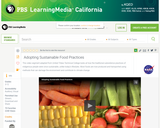
Hear about how respect for Earth can help us attain a more sustainable lifestyle in the face of climate change in this video segment adapted from United Tribes Technical College.
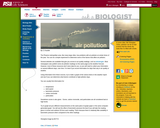
The Phoenix metropolitan area, like many large cities, has problems with air pollution at certain times of the year. You can do a simple experiment to determine some of the factors that affect air pollution.
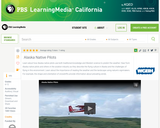
In this video adapted from Storyknife Productions, Alaska Native pilots share how they use traditional knowledge to read the landscape and predict the weather.

In this video adapted from KUAC-TV and the Geophysical Institute at the University of Alaska, Fairbanks, Alaska Native students contribute to research on how their environment is changing as a result of global warming.
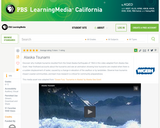
In this video adapted from Alaska Sea Grant, discover why multiple tsunamis resulted from the Great Alaska Earthquake of 1964.

This course discusses how to use algebra for a variety of everyday tasks, such as calculate change without specifying how much money is to be spent on a purchase, analyzing relationships by graphing, and describing real-world situations in business, accounting, and science.
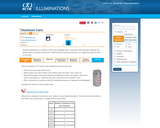
In this data analysis activity students investigate data in connection with recyclable materials and develop plans to help the environment. Students collect data about aluminum can usage and graph that data in a line plot. The lesson includes student worksheet and extension suggestions.
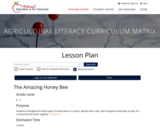
Students investigate the three types of honey bees in a colony, identify their roles, and recognize honey bees as part of a community that works together
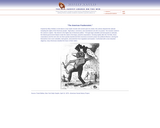
Inspired by Mary Shelley's novel about a man-made monster who turned upon its creator, this cartoon depicted the railroad trampling the rights of the American people. Agriculture
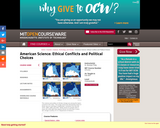
Explores the changing roles, ethical conflicts, and public perceptions of science and scientists in American society from World War II to the present. Studies specific historical episodes focusing on debates between scientists and the contextual factors influencing their opinions and decisions. Topics include the atomic bomb project, environmental controversies, the Challenger disaster, biomedical research, genetic engineering, (mis)use of human subjects, scientific misconduct and whistleblowing.

Farming ants might sound like a crazy thing to do unless you might like to eat chocolate covered ants. It turns out we can learn a lot from ants and the best way is to build your own ant farm.

Meet the Antibiotic Hunters—a team of professional and student scientists at the Tiny Earth Network who search for new antibiotics in the soil.
Resources available for learning about this lab include:
• Interactive cards designed to introduce students to scientists in a more personal way
• A video with a personal story that explains why the lab's research matters in real life
• Questions to consider that will spark connection, reflection, and conversation
• An interactive video experience where you can ask questions of scientists in the lab and learn about their research
• An inquiry-based activity that focuses on doing science, using some of the same science practices that the lab uses
• An educator guide with information about standards alignment, curriculum connections, and tips for using the media resources
These resources are part of Meet the Lab, a collection of educational resources for middle school science classrooms.
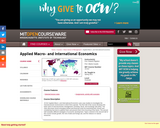
Applied Macro- and International Economics uses case studies to investigate the macroeconomic environment in which firms operate. The first half of the course develops the basic tools of macroeconomic management: monetary, fiscal, and exchange rate policy. The class discusses recent emerging market and financial crises by examining their causes and considering how best to address them and prevent them from recurring in the future. The second half evaluates different strategies of economic development. Topics covered in the second half of this course include growth, the role of debt and foreign aid, and the reliance on natural resources.
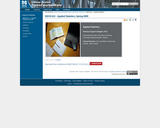
I designed the course for graduate students who use statistics in their research, plan to use statistics, or need to interpret statistical analyses performed by others. The primary audience are graduate students in the environmental sciences, but the course should benefit just about anyone who is in graduate school in the natural sciences. The course is not designed for those who want a simple overview of statistics; well learn by analyzing real data. This course or equivalent is required for UMB Biology and EEOS Ph.D. students. It is a recommended course for several of the intercampus graduate school of marine science program options.